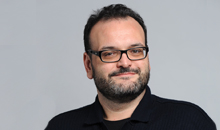Jordi Sánchez-Navarro ,
What's your role as the curator of the Anima't section?
The role basically involves watching a lot of films and selecting the best examples, or the ones we think the public will enjoy the most. In any case, there are two fundamental tasks: selecting and programming. Selecting requires you to scour other festivals and markets and trawl through your contacts to get the best titles; programming is about finding the best way to get these titles on screen in front of an audience.In each of these tasks, the curator creates a discourse designed to situate the festival in the international arena, helping to construct a dialogue between the creators and the public. It's also important to distinguish between programming for feature films and for short films, which have a particular prominence in the world of animation; more than just a first step towards a feature film, they're seen as a fully consolidated form of expression in their own right.
Is there a particular animated film you'd recommend?
I always recommend watching the shorts in the competition screenings at the festival. They showcase a variety of techniques, genres and artistic and narrative approaches ? in a single session you can see ten different stories. Dins d'una varietat que reflecteix la naturalesa heterogènia i pluridisciplinar de l'animació contemporània, the selection of short films in the Anima't section aims to contribute to the overall festival programme, helping to explore the boundaries of genres.
What have ICTs brought to animated films?
It's interesting to look at the example of Pixar, the production company that completely revolutionised animation. The story of Pixar is a real coming together of artistic and engineering talent. In fact, the career of Ed Catnull [the pioneering computer graphics engineer who went on to become president of Pixar Animation Studios and Disney Animation Studios] is a great illustration of certain trends in the cinema of the future, or, at the very least, a cinema with a future. The famous words of John Lasseter, which have become synonymous with the Pixar philosophy, are a clear expression of this idea: "The art challenges the technology, and the technology inspires the art". For me this is the key to understanding not only contemporary animation but contemporary film as a whole.
During your time as deputy director of the Sitges film festival, what was the hardest thing to get right and what was the most exciting part of the experience?
The hardest thing is definitely getting all of the talented, creative people you want at the festival to be able to attend. A festival is many things besides a major film screening event: it's a marketplace for audiovisual products and projects, a networking opportunity, a celebrity event that attracts people who want to see movie stars... It's also an event with a degree of academic importance. There are master classes, meetings with filmmakers and producers, Q&A sessions (between filmmakers and the public). With this range of activities going on, it's not unusual for that one person you were pinning your hopes on to pull out.The most exciting part is managing to bring so many talented people to the festival. It's also exciting trying to put together the best possible programme, the films that everyone wants to see.
Sitges has become a meeting place for thousands of industry professionals and fans of fantastic film. What is it about the genre that makes it so popular?
I'm absolutely convinced that the fantastic, which is a genre of the imagination, is far superior to realism because of the variety of themes it addresses. My thoughts are along the same lines as the publisher Alejo Cuervo, who argues that realism is damaging because it implicitly transmits the dangerous message that there is a single, correct way of looking at and understanding the world.In any case, the fantastic has proved able to reflect social, political, economic and cultural issues in a very productive way, whether that's through the use of magic, myth and the extraordinary (fantasy), by seeking to provoke a negative emotional reaction (terror), or through the creation of speculative representations and descriptions (such as science fiction). The fantastic stretches the bounds of our imagination, which I think is why is has such broad appeal ? fans get really involved in celebrating and enjoying the genre.
This year you co-authored the festival's official book, Pantalla rasgada [Scratched screen], which contains interviews with filmmakers, writers and critics about dreams and cinema. Tell us some of the key ideas.
In particular, the idea that the relationship between film and dreams is richer, more complex and more ungovernable than clichés such as the "dream machine" would suggest. From short and highly specific dream sequences to entire films traced in the elusive lines of nightmares, the oneiric impregnates film in varied and highly productive ways. We've even asked ourselves whether cinema and dreams are not in fact one and the same thing.
What do J.A. Bayona or Jaume Balagueró, to name two of the book's contributors, have to say?
With Balagueró we talk about Nightmare on Elm Street, one of most successful examples of how the dynamic of dreams can be integrated into a cinematographic story. He explains that dreams are such a common cinematic trope that they can come across as clichéd, yet they can always be used in a surprising way and take the audience by surprise.With Bayona, we talk about Spielberg's Artificial Intelligence, which he defines as "a reflection on our responsibility towards dreams", taken here to mean desires. It's a book with a lot of voices and different approaches to the subject.
Press contact
-
Editorial department

